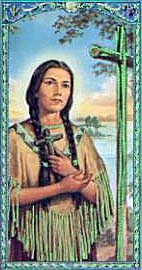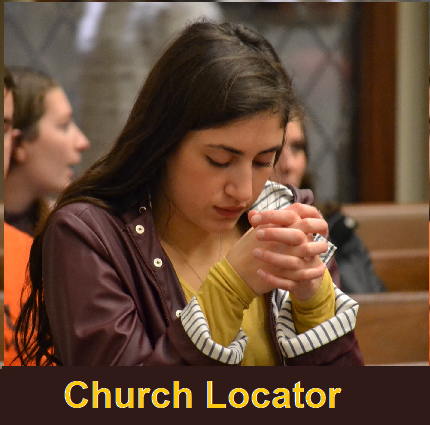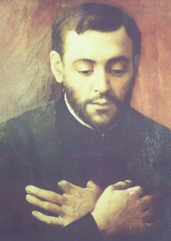.
The young Jesuit lay prostrate before the Blessed Sacrament in the mission chapel in New France. As he begged God for the privilege of suffering for the sake of the Indians he sought to bring to Christ, he heard his calling answered as in words: “Your prayer has been heard. Be it done to you as you have asked. Be comforted, be of strong heart.” Father rejoiced in these words. He believed that they were a prophecy, “issued from the lips of him with whom saying and doing are only one and the same thing.”
This conviction that God had spoken to him sustained Jogues throughout his ministry, especially during his captivity and torture by the Mohawks. Ultimately, his prayer would be fulfilled with his martyrdom. Isaac Jogues was born into a devout merchant family in France on January 10, 1607. During his boyhood years, Franciscan and Jesuit missionaries were making their first efforts to evangelize the
Black Robe
Saint Isaac Jogues
"A Real Indian Story"
natives in the New World. By the time Isaac entered the Jesuit apprenticeship in 1624, a Jesuit mission had been established among the Indians in Huronia (the present province of Ontario). Twelve years of discipline, study, and prayer prepared Isaac well for the life he anticipated as a missionary--though the hardships he would face in the rugged wilderness of New France were far different from his cultured French upbringing. Shortly after his ordination in 1636, the twenty-nine-year-old priest sailed for Quebec with four other Jesuits. From 1636 until 1642, Fr. Jogues lived among the natives in Huronia, who named him Ondessonk (bird of prey) because of his keen eye.
There, under the instruction of the veteran missionary Fr. Jean de beuf, he learned the language and customs of the Hurons, and together with the Indians and his fellow missionaries, Jogues suffered from sickness, hunger, and the hardships of the climate. In addition, Huron sorcerers jealous of the priests’ growing influence blamed them for crop failures, poor hunting, or defeats in battle and frequently threatened to kill them. Yet despite all these challenges, some of the Hurons came to profess their belief in the Christian God and accepted baptism.
Under Deaths Shadow In the summer of 1642, while returning in heavily loaded canoes from a journey to Quebec to replenish the missionaries’ supplies, Jogues, two French lay missionaries, and almost forty Hurons were ambushed by Mohawks. One of the five nations of the Iroquois, the Mohawks were relentless enemies of the Hurons. The two laymen and eighteen of the Hurons--many of whom were Christians--were taken prisoner. The others were killed or escaped into the woods. In the melee, Jacques canoe capsized, and he lay hidden among the reeds. Rather than flee, he surrendered himself to the Mohawks so that he could accompany his companions and offer whatever help he could in the ordeals sure to follow. Over the course of the next few weeks, the captives were paraded triumphantly from village to village, made to run the gauntlet, and subjected to hideous torture. The Mohawks pulled out their hair and beards, cut slices of flesh from them--which they roasted and ate in front of them--and tore out their fingernails. They also crushed the bones of Jogues forefingers between their teeth and sawed off his left thumb with an oyster shell. At night, the prisoners were tied spread-eagle to the ground, and the children were encouraged to throw live coals on their bare flesh. One of the laymen and many of the Hurons were killed during these ordeals. In spite of his own pain, Jogues heard his companions’ confessions, gave absolution and comfort, and baptized the catechumens. None of them wavered in their new faith.
When the Mohawks’ fury abated, they decided to hold Jogues --the “Blackrobe”--hostage and make him a slave. They forced him to do hard tasks and carry heavy loads. They fed him very little, gave him no warm clothing, and constantly threatened to kill him. However, he was adopted into the Wolf clan, and his new “aunt” gave him some measure of freedom to pray alone and to talk with the villagers. Rather than hating his captors, Jogues prayed unceasingly for them and sought to bring as many of them as possible to salvation. Learning the Mohawks’ language, he entered the lodgehouses--just as he had done among the Hurons in search of the sick, so that he might win them to Christ before they died. He even nursed the brave who had torn out his fingernails. During his captivity, Jogues managed to baptize seventy dying Mohawks. He also consoled and baptized Huron prisoners who were brought into the village for torture and execution.
After a year as a slave of the Mohawks, Jogues was able to escape when he was taken along to a settlement where the Mohawks traded with the Dutch. He remained in hiding for weeks until the Dutch could transport him down the Hudson to Manhattan and on to where he landed on Christmas Eve 1643. Jogues was welcomed as a living martyr by his fellow Jesuits. Queen Anne received him as an honored guest and examined his mangled fingers with tears in her eyes. A humble man, Jogues was distressed by these honors and longed to be back among the Indians. In the spring of 1644, after only a three-month stay in his own country, Jogues’ superiors allowed him to return to New France. In the year after Jogues return, the Iroquois, Mohawk and French began to negotiate a peace treaty. Governor Montmagny asked him to be an ambassador representing the French. As the Jesuit understood the Mohawk language and the Iroquois knew of his high standing among the French, there could be no better peace envoy. Jogues readily agreed, though this meant returning to the Mohawk village where he had been tortured and enslaved.
Jogues and his companions reached the village in June 1646. A great multitude gathered to see the party, and those who had once made life so miserable for him now pretended to have forgotten their past deeds and greeted him cordially. An assembly of the chiefs was held, compassionate speeches were given promising peace, and furs and belts of wampum were exchanged. The council ended favorably, and Jogues again began to administer the sacraments to Christian captives and baptize the dying. The mission of diplomacy completed, the peace envoy returned to Quebec , but Jogues left a chest containing Mass supplies and personal effects, hoping to return the next season. He showed the box and its contents to the villagers, assured them there was nothing harmful in it, and entrusted it to them.
Though eager to establish a Mohawk mission, Isaac and his superiors were cautious. Not long afterward, however, conditions seemed favorable and it was decided that Jogues should winter among the Iroquois. He wrote to a friend in France, “My heart tells me that if I have the happiness of being employed in this mission, I shall go never to return; but I shall be happy if our Lord will complete the sacrifice where he has begun it, and make the little blood I have shed in that land the pledge of what I would give from every vein of my body and my heart. In a word, this people is ‘a bloody spouse to me’--‘In my blood have I espoused them to me’ May our good Master who has purchased them in His blood, open to them the door of His gospel, as well as to the four allied nations near them. Farewell, dear Father; pray to him to unite me inseparably to him.”
On September 24, Jogues left for his third journey to the Five Nations, accompanied by a layman, John de Lalande, and some Huron companions. As they approached the village, the group was attacked by a war party and taken captive. Jogues reminded the Indians of their invitation for him to return and of the treaty, but to no avail. They angrily accused the Blackrobe of having put a curse on them--they had experienced a scourge of disease and a plague of worms that destroyed their crops--and they blamed the chest he had left among them for their misfortunes. Jogues’ “adoptive” Wolf clan defended him, and the chiefs’ council honored the treaty and let him live. The Bear clan, however, decided to kill Jogues on their own.
On the evening of October 18, 1646 Jogues was invited to a feast in one of the Mohawk lodgehouses. As he stooped to enter through the low door, the brave following behind him split his skull with a tomahawk. The traitors immediately cut off his head and displayed it on the palisades of the village. The next day, they killed John de Lalande and the Hurons. News of the martyrdoms did not reach Quebec until June 1647.
The Iroquois broke the treaty with the French and, in the following years, mercilessly attacked the Hurons. They destroyed all their villages and the Jesuit mission posts among them. Fathers Jean de beuf, Gabriel Lalemant, Charles Garnier, Anthony Daniel, and Noel Charbanel were martyred in Huronia between July 4, 1648 , and December 8, 1649. Within months after these martyrdoms, fourteen hundred Hurons were converted to Christ. The seed of faith was watered by the blood of these martyrs, and an abundance of souls harvested for heaven. The brave who tomahawked Jogues and another who had been wounded attempting to deflect the blow from the victim were later converted to Christianity. The murderer took “Isaac” as his baptismal name and died repentant, satisfied that he was going to heaven. Ten years after Jogues was martyred, Kateri Tekakwitha was born in the same village and became a firm witness to Christ through the undaunted efforts of the Jesuits who followed the first North American martyrs. The first native American to be beatified, Kateri is among the fruits for whom Isaac Jogues shed his blood in the hopes that his holocaust would hasten the conversion of the Mohawks.
by the RCIA team 2004 Saint Thomas Aquinas Catholic Church, Hyde Park - Utah
Updated by Richard Horrell / Lay Missionary Catholic RCIA 2019 -COPYRIGHT All rights reserved
Phone: 530-903-0121 Email: rchorrel@aol.com
Treasured Writing
Evangelization
- Isaiah 6:8b




